Advertisements
Advertisements
Question
Which of the following is true for displacement?
- It cannot be zero.
- Its magnitude is greater than the distance travelled by the object.
Solution
- False
Displacement can become zero when the initial and final positions of the object are the same. - False
Displacement is the shortest measurable distance between the initial and final positions of an object. It cannot be greater than the magnitude of the distance travelled by an object. However, sometimes it may be equal to the distance travelled by the object.
APPEARS IN
RELATED QUESTIONS
Clarify the difference.
Distance and displacement
Figure shows the displacement-time graph of two vehicles A and B moving along a straight road. Which vehicle is moving faster? Give reason.

A car starting from rest accelerates uniformly to acquire a speed 20 km h-1 in 30 min. The distance travelled by a car in this time interval will be _____________
A racehorse runs straight towards the north and covers 540 m in one minute. Calculate
- displacement of the horse,
- its velocity in (a) ms−1 (b) kmh−1.
An object is thrown vertically upwards. It rises upto a height H and then returns to its initial position. Calculate
The total distance traveled by the object
A car travels at a uniform speed of 42 km/h. In 10 minutes, how much distance would it cover?
The figure represents graphically the velocity of a car moving along a straight road over a period of 100 hours.
Calculate the distance travelled in the last 40 h.
Give one example where the displacement is zero but the distance travelled is not zero.
A man leaves his house at 6.30 a.m. for a morning walk and returns back at 7.30 a.m. after covering 4 km. The Displacement covered by him is ______.
A quantity that has both magnitude and direction is ______.
